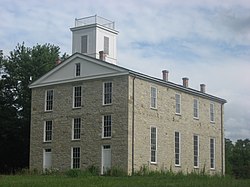
The list of Underground Railroad sites includes abolitionist locations of sanctuary, support, and transport for former slaves in 19th century North America before and during the American Civil War. It also includes sites closely associated with people who worked to achieve personal freedom for all Americans in the movement to end slavery in the United States.
Contents
- Canada
- Ontario
- Nova Scotia
- United States
- Colorado
- Connecticut
- Delaware
- District of Columbia
- Florida
- Georgia
- Illinois
- Indiana
- Iowa
- Kansas
- Maine
- Maryland
- Massachusetts
- Michigan
- Nebraska
- New Jersey
- New York
- North Carolina
- Ohio
- Pennsylvania
- Rhode Island
- Tennessee
- Texas
- Vermont
- Virgin Islands
- Virginia
- West Virginia
- Wisconsin
- Other articles and references
- See also
- References
- Bibliography
- External links
The list of validated or authenticated Underground Railroad and Network to Freedom sites is sorted within state or province, by location.











